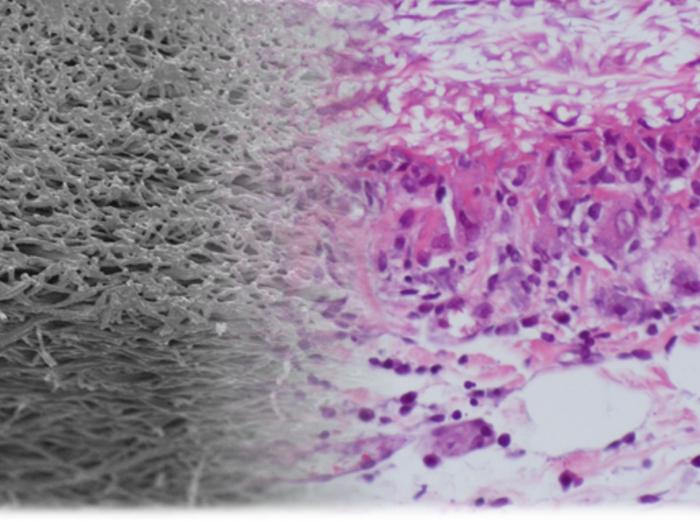Scientists have developed a new biodegradable material for creating artificial
blood vessels that is much more compatible with body tissue than those currently used.
After successfully testing it in rats, the team believes it will lead to greater use of
artificial blood vessels in human patients.

The new artificial material (left) combined well with natural body tissue (right).
Image credit: Vienna University of Technology
The team – from Vienna University of Technology and Vienna Medical University in
Austria – describes how they made and tested the new material in a paper published in the
journal Acta Biomaterialia.
Blocked blood vessels can quickly become very dangerous – they are one of the most
common causes of death in industrialized countries.
It is often necessary to replace blocked blood vessels – for instance in a bypass
operation – either with other vessels taken from the body or with artificial ones.
Artificial blood vessels are made from biodegradable materials that gradually populate
with live cells to make new tissue. As the artificial material dissolves, the new tissue
takes over.
However, the researchers say that the artificial materials currently available are
not ideally compatible with body tissue. They note in their paper:
“Current approaches often reveal limited tensile strength and therefore
require thicker or reinforced graft walls.”
Another problem with currently available materials is they can cause the new blood
vessel to become blocked, especially if it is only small in diameter.
New material makes blood vessel walls very similar to natural ones
In their paper, the researchers describe how they developed a new polymer – made from
thermoplastic polyurethane – with much improved mechanical properties that can be made
into vessels with walls that are very similar to natural ones.
The artificial vessels are made by spinning the polymer in an electrical field to form
very fine threads that are then wound onto a spool.
The polymer fabric is slightly porous – this allows some blood to soak into and enrich
the walls with growth factors, which encourages the migration of native cells.
Tests of the new artificial blood vessels in rats, showed that after 6
months there was no evidence of bulging (aneurysm), blockage (thrombosis) or
inflammation.
First author Helga Bergmeister, an assistant professor in biomedical research at the
Medical University of Vienna, says:
“Endogenous cells had colonized the vascular prostheses and turned the
artificial constructs into natural body tissue.”
The researchers were surprised that natural body tissue re-grew much faster than they
expected. They suggest this means that the artificial vessels can be made to degrade more
quickly.
The team is now looking at how to improve the material even further.
They note that while more preclinical trials are needed, they are optimistic that
their new material will be ready for human use in a few years.
Meanwhile, Medical News Today recently learned about another study where
scientists successfully used stem cells from human
amniotic fluid to boost blood vessel growth in healing hydrogels injected into mice.
The new blood vessels were robust and fully functioning.